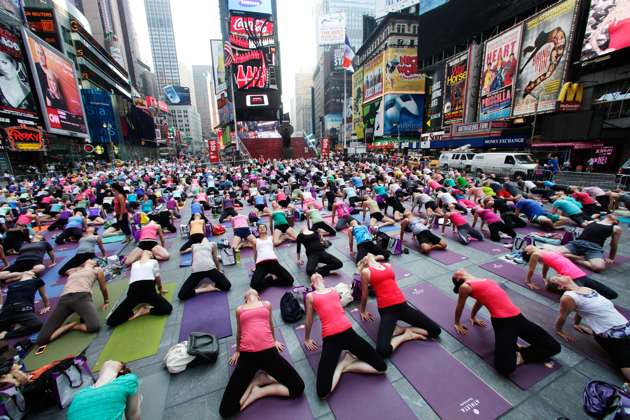About two-thirds into the yoga class, I prepare to rise into Locust Pose. All good, until another yogi’s toe taps my nose. I think about shimmying back a few inches, but don’t want to blind the third eye of the yogi behind me with my own big toe.
Sound familiar? If you’ve practiced in a big city with a popular instructor, I’m sure you’ve got your own foot-in-face story to tell. On the Flip Dog side, I’ve taken classes with just one or two other yogis—struggling to create enough energy to keep from slipping into Savasana before opening Salutations.
If the size of class you signed up for just isn’t in your sweet spot, please don’t bail. Instead, use the empty cavern or packed sardine can as an opportunity to improve your practice. Here’s how.
1. Find friends
When I moved across the country two years ago, I developed a kink in my neck from all the phone chatter with family and pals I missed back home.
Finally, I found several local yoga studios and figured out who the most inspiring instructors were and wedged my mat in between all the other yogis following in herds. I’d be lying if I said I never let out an audible sigh or menacing glare to get a latecomer to back the hell away from my mat.
But more often, I met like-minded yogis who are now my friends and meet me for coffee afterwards (in a jam-packed joint, of course). In no time, my neck found relief and my phone bills dropped.
2. Improve your teaching chops.
My first teaching gig was at a small neighborhood studio where the guru-owner packed ‘em in while I could have shot a cannon down the middle of my empty class and still adhered to Ahimsa.
As I slowly built a following, however, my small classes gave me the giant opportunity to focus intently on each individual student, affording me ample time to give thoughtful alignment cues and adjustments based on their specific needs.
In a packed class, a teacher simply can’t provide that level of detailed refinement for each individual student. Students, too, can learn a ton with the extra hands-on attention. When there’s nowhere to hide, you have no choice but to truly participate. This is a good thing.
3. Strengthen your breath.
In a small class, you naturally breathe bigger to keep the energy alive. Likewise, when sandwiched between a pair of Darth Vader twins in a packed Power Hour, your conscious breathing will at least take your mind off the Star Wars competition flanking your Downward Dog. May the force be with you, too.
4. Heighten your awareness.
Every week, I take an odd-hour class that rarely attracts more than a handful of yogis. I do this on purpose, knowing my awesome teacher will pick up on my every attempt to check out.
Ever seen those gym rats hangin’ onto the handrails of the elliptical machine for dear life as they flip through the latest gossip trash mag? Admit it. We yogis have our own version of “hangin’ on the rails” mindlessness.
For me, it comes about in a torturously long Side Angle. My forearm wants to take over for my legs—until my awesome teacher catches me in the act and gently guides me back to awareness. Ah, the joy and pain of a small class!
Likewise, in a packed class, checking out in a balancing pose can, and likely will, create an ugly domino effect of falling yogis and one hot mess for the teacher to clean up. Don’t be that yogi: be aware!
5. Go with the flow, baby.
Go ahead, take a class you don’t normally attend.
See how it feels to be the center of attention in a small class if you normally squeeze into the back corner of Popular Paul’s Power Hour. Observe where your mind goes in a packed room between a sea of arms and legs unlike the vast ocean of space you’re more familiar with.
Can you ride the wave or will you sink to the bottom? Practicing in a new and sometimes uncomfortable environment helps us go inward and discover new strengths, keeping us stimulated and present. Downward Dog in a new environment will be anything but ordinary.
Now try these tips next time you hit the studio and maximize your efforts during practice. Namaste and see you in class.


